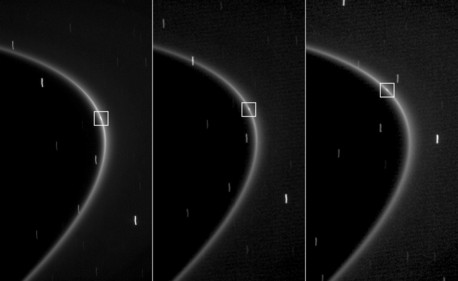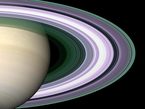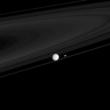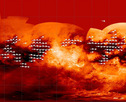Source of outer ring found
Newfound moon source of Saturn ring
NASA's Cassini spacecraft has found within Saturn's G ring an embedded moonlet that appears as a faint, moving pinprick of light. Scientists believe it is a main source of the G ring and its single ring arc. The G ring was the only dusty ring that was not clearly associated with a known moon, which made it odd.
 © NASA/JPL/SSI |
This sequence of three images, obtained over the course of about 10 minutes, shows the path of a newly found moonlet in a bright arc of Saturn's faint G ring. Note that this streak is aligned with the G ring and moves along the ring.
Analyzing images acquired over the course of about 600 days scientists found the tiny moonlet, about a third of a mile across, embedded within a partial ring, or ring arc, previously found in Saturn's tenuous G ring.
"Before Cassini, the G ring was the only dusty ring that was not clearly associated with a known moon, which made it odd," said Matthew Hedman, a Cassini imaging team associate at Cornell University in Ithaca, N.Y. "The discovery of this moonlet, together with other Cassini data, should help us make sense of this previously mysterious ring."
Saturn's rings were named in the order they were discovered. Working outward they are: D, C, B, A, F, G and E. The G ring is one of the outer diffuse rings. Within the faint G ring there is a relatively bright and narrow, 250-kilometer-wide (150-miles) arc of ring material, which extends 90,000 miles, or one-sixth of the way around the ring's circumference. The moonlet moves within this ring arc. Previous Cassini plasma and dust measurements indicated that this partial ring may be produced from relatively large, icy particles embedded within the arc, such as this moonlet.
The moonlet is too small to be resolved by Cassini's cameras, so its size cannot be measured directly. However, Cassini scientists estimated the moonlet's size by comparing its brightness to another small Saturnian moon, Pallene.
Hedman and his collaborators also have found that the moonlet's orbit is being disturbed by the larger, nearby moon Mimas, which is responsible for keeping the ring arc together.
Carl Murray, professor at Queen Mary, University of London, said, "The moon's discovery and the disturbance of its trajectory by the neighboring moon Mimas highlight the close association between moons and rings that we see throughout the Saturn system. Hopefully, we will learn in the future more about how such arcs form and interact with their parent bodies."
Source: NASA
"Before Cassini, the G ring was the only dusty ring that was not clearly associated with a known moon, which made it odd," said Matthew Hedman, a Cassini imaging team associate at Cornell University in Ithaca, N.Y. "The discovery of this moonlet, together with other Cassini data, should help us make sense of this previously mysterious ring."
Saturn's rings were named in the order they were discovered. Working outward they are: D, C, B, A, F, G and E. The G ring is one of the outer diffuse rings. Within the faint G ring there is a relatively bright and narrow, 250-kilometer-wide (150-miles) arc of ring material, which extends 90,000 miles, or one-sixth of the way around the ring's circumference. The moonlet moves within this ring arc. Previous Cassini plasma and dust measurements indicated that this partial ring may be produced from relatively large, icy particles embedded within the arc, such as this moonlet.
The moonlet is too small to be resolved by Cassini's cameras, so its size cannot be measured directly. However, Cassini scientists estimated the moonlet's size by comparing its brightness to another small Saturnian moon, Pallene.
Hedman and his collaborators also have found that the moonlet's orbit is being disturbed by the larger, nearby moon Mimas, which is responsible for keeping the ring arc together.
Carl Murray, professor at Queen Mary, University of London, said, "The moon's discovery and the disturbance of its trajectory by the neighboring moon Mimas highlight the close association between moons and rings that we see throughout the Saturn system. Hopefully, we will learn in the future more about how such arcs form and interact with their parent bodies."
Source: NASA
Source of outer ring found
Newfound moon source of Saturn ring
NASA's Cassini spacecraft has found within Saturn's G ring an embedded moonlet that appears as a faint, moving pinprick of light. Scientists believe it is a main source of the G ring and its single ring arc. The G ring was the only dusty ring that was not clearly associated with a known moon, which made it odd.
 © NASA/JPL/SSI |
This sequence of three images, obtained over the course of about 10 minutes, shows the path of a newly found moonlet in a bright arc of Saturn's faint G ring. Note that this streak is aligned with the G ring and moves along the ring.
Analyzing images acquired over the course of about 600 days scientists found the tiny moonlet, about a third of a mile across, embedded within a partial ring, or ring arc, previously found in Saturn's tenuous G ring.
"Before Cassini, the G ring was the only dusty ring that was not clearly associated with a known moon, which made it odd," said Matthew Hedman, a Cassini imaging team associate at Cornell University in Ithaca, N.Y. "The discovery of this moonlet, together with other Cassini data, should help us make sense of this previously mysterious ring."
Saturn's rings were named in the order they were discovered. Working outward they are: D, C, B, A, F, G and E. The G ring is one of the outer diffuse rings. Within the faint G ring there is a relatively bright and narrow, 250-kilometer-wide (150-miles) arc of ring material, which extends 90,000 miles, or one-sixth of the way around the ring's circumference. The moonlet moves within this ring arc. Previous Cassini plasma and dust measurements indicated that this partial ring may be produced from relatively large, icy particles embedded within the arc, such as this moonlet.
The moonlet is too small to be resolved by Cassini's cameras, so its size cannot be measured directly. However, Cassini scientists estimated the moonlet's size by comparing its brightness to another small Saturnian moon, Pallene.
Hedman and his collaborators also have found that the moonlet's orbit is being disturbed by the larger, nearby moon Mimas, which is responsible for keeping the ring arc together.
Carl Murray, professor at Queen Mary, University of London, said, "The moon's discovery and the disturbance of its trajectory by the neighboring moon Mimas highlight the close association between moons and rings that we see throughout the Saturn system. Hopefully, we will learn in the future more about how such arcs form and interact with their parent bodies."
Source: NASA
"Before Cassini, the G ring was the only dusty ring that was not clearly associated with a known moon, which made it odd," said Matthew Hedman, a Cassini imaging team associate at Cornell University in Ithaca, N.Y. "The discovery of this moonlet, together with other Cassini data, should help us make sense of this previously mysterious ring."
Saturn's rings were named in the order they were discovered. Working outward they are: D, C, B, A, F, G and E. The G ring is one of the outer diffuse rings. Within the faint G ring there is a relatively bright and narrow, 250-kilometer-wide (150-miles) arc of ring material, which extends 90,000 miles, or one-sixth of the way around the ring's circumference. The moonlet moves within this ring arc. Previous Cassini plasma and dust measurements indicated that this partial ring may be produced from relatively large, icy particles embedded within the arc, such as this moonlet.
The moonlet is too small to be resolved by Cassini's cameras, so its size cannot be measured directly. However, Cassini scientists estimated the moonlet's size by comparing its brightness to another small Saturnian moon, Pallene.
Hedman and his collaborators also have found that the moonlet's orbit is being disturbed by the larger, nearby moon Mimas, which is responsible for keeping the ring arc together.
Carl Murray, professor at Queen Mary, University of London, said, "The moon's discovery and the disturbance of its trajectory by the neighboring moon Mimas highlight the close association between moons and rings that we see throughout the Saturn system. Hopefully, we will learn in the future more about how such arcs form and interact with their parent bodies."
Source: NASA









